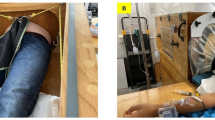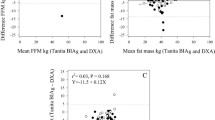Abstract
Tetrapolar, whole-body (hand-foot) bioelectrical impedance (Zwb) is utilized in body composition analysis for direct assessment of soft tissue hydration (Vector BIA) and indirect assessment of lean and fat soft tissue mass (BIA prediction equations). Limbs and trunk contribute to Zwb by 90% and 10%, respectively. We determined the effect on Zwb of local edema localized in one leg. Resistance (R) and reactance (Xc) components of Z vector was measured at 50 kHz (BIA-101, RJL Systems-Akern, Italy) in 20 adult male patients without edema, before and three days after a surgical procedure on vessels of one leg (femoro-popliteal bypass) that induced pitting edema in that leg. Zwb were measured from hand and foot of the right and left side. Z from the leg (Zleg) was measured from the pair of electrodes on foot and the other pair on the trochanter. Data were analyzed with Vector BIA (Piccoli’s RXc graph method, 95% confidence ellipses) that considers Zwb and Zleg as bivariate gaussian random vectors (expressed in Ohm/meter of conductor). Baseline mean vector from legs of either side, Zleg was significantly shorter than Zwb on the R-Xc plane (separate 95% confidence ellipses).
Access this chapter
Tax calculation will be finalised at checkout
Purchases are for personal use only
Preview
Unable to display preview. Download preview PDF.
Similar content being viewed by others
References
Grimnes S, Martinsen ØG (2001) Bioimpedance and bioelectricity basics. Academic Press, London
Foster KF, Lukaski HC (1996) Whole-body impedance - what does it measure? Am J Clin Nutr 64(suppl):388S-396S.
Houtkooper LB, Lohman TG, Going SB et al (1996) Why bioelectrical impedance analysis should be used for estimating adiposity. Am J Clin Nutr 64(suppl):436S-448S.
Chumlea WC, Baumgartner RN, Roche AF (1988) Specific resistivity used to estimate fat-free mass from segmental body measures of bioelectric impedance. Am J Clin Nutr 48:7-15.
Piccoli A, Rossi B, Pillon L (1994) Operational equivalence between segmental and whole-body bioelectrical impedance in renal patients. Am J Clin Nutr 59:675-676.
Levin NW, Zhu F, Seibert E, Ronco C, Kuhlmann MK (2005) Use of segmental multifrequency bioimpedance spectroscopy in hemodialysis. Contrib Nephrol 149:162-167.
Zhu F, Schneditz D, Kaufman AM, Levin NW (2000) Estimation of body fluid changes during peritoneal dialysis by segmental bioimpedance analysis. Kidney Int 57:299-306.
Piccoli A, for the Italian CAPD-BIA study group (2004) Bioelectric impedance vector distribution in peritoneal dialysis patients with different hydration status. Kidney Int 65:1050-1063.
Piccoli A, Rossi B, Pillon L, Bucciante G (1994) A new method for monitoring body fluid variation by bioimpedance analysis: The RXc graph. Kidney Int 46:534-539.
Piccoli A (2002) Patterns of bioelectrical impedance vector analysis: learning from electrocardiography and forgetting electric circuit models. Nutrition 18:520-527.
Piccoli A (2005) Whole body – single frequency bioimpedance. Contrib Nephrol 149:150-161.
Piccoli A, Nigrelli S, Caberlotto A et al (1995) Bivariate normal values of the bioelectrical impedance vector in adult and elderly populations. Am J Clin Nutr 61:269-270.
Piccoli A, Pillon L, Dumler F (2002) Impedance vector distribution by sex, race, body mass index, and age in the United States: standard reference intervals as bivariate Z scores. Nutrition 18:153-167.
Piccoli A, Brunani A, Savia G et al (1998) Discriminating between body fat and fluid changes in the obese adult using bioimpedance vector analysis. Int J Obesity 22:97-104.
Piccoli A, Pastori G, Guizzo M, Rebeschini M, Naso A, Cascone C (2005) Equivalence of information from single versus multiple frequency bioimpedance vector analysis in hemodialysis. Kidney Int 67:301-313.
Piccoli A, Pastori G, Codognotto M, Paoli A (2007) Equivalence of information from single frequency v. bioimpedance spectroscopy in bodybuilders. Br J Nutr 97:182-192.
Piccoli A, Pastori G (2002) BIVA software. Department of Medical and Surgical Sciences, University of Padova, Italy, at apiccoli@unipd.it.
Author information
Authors and Affiliations
Editor information
Editors and Affiliations
Rights and permissions
Copyright information
© 2007 Springer-Verlag Berlin Heidelberg
About this paper
Cite this paper
Codognotto, M., Piccoli, A., Piazza, M., Frigatti, P. (2007). Sensitivity of whole-body bioelectrical impedance to edema in one leg. In: Scharfetter, H., Merwa, R. (eds) 13th International Conference on Electrical Bioimpedance and the 8th Conference on Electrical Impedance Tomography. IFMBE Proceedings, vol 17. Springer, Berlin, Heidelberg. https://doi.org/10.1007/978-3-540-73841-1_204
Download citation
DOI: https://doi.org/10.1007/978-3-540-73841-1_204
Publisher Name: Springer, Berlin, Heidelberg
Print ISBN: 978-3-540-73840-4
Online ISBN: 978-3-540-73841-1
eBook Packages: EngineeringEngineering (R0)




